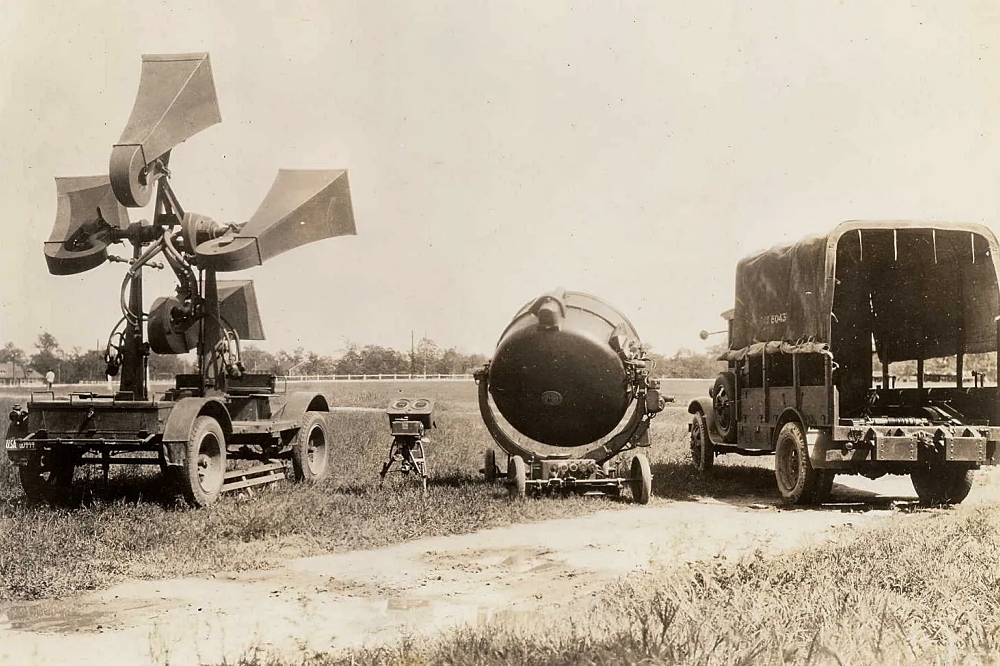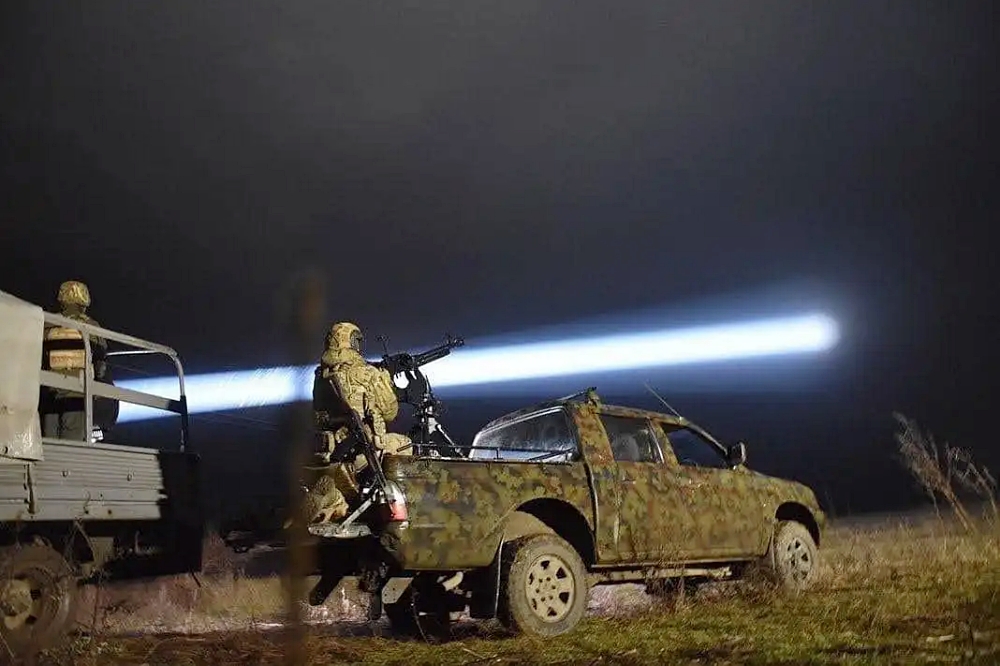The U.S. should integrate a low-cost acoustic network to detect aerial threats developed by Ukraine into its own air defense systems, the commanding general of the U.S. Army Space and Missile Defense Command said Wednesday morning.
Consisting of thousands of acoustic sensors across Ukraine, this system helps detect and track incoming Russian kamikaze drones, alert traditional air defenses in advance, and also dispatch ad hoc drone hunting teams to shoot them down.
“Their use of acoustic sensors has proliferated across the country to the point now where they’re almost positively identifying drones in the distance because of this acoustic and the fireteams attached to that acoustic, low-cost capability that they’ve developed and proliferated,”
Army Lt. Gen. Stephen Gainey said during a discussion at the Hudson Institute. As a result, Ukraine has a “low-cost defeat” system. The U.S., he added, should
“find a way” of integrating “that type of low-cost capability into our system. We should be able to find ways to work together and augment some of our capability with some of that lower-cost capability.”One of the key lessons from Ukraine that could be applied to the U.S. is “the ability to be able to disperse our capability [across a full 360 degrees] and be able to respond to several different threats simultaneously,” Gainey said.
Gainey didn’t offer details of how such an integration might work. However, his comments about U.S. interest in Ukraine’s acoustic detection network echoed sentiments expressed last week by the general who leads U.S. Air Forces in Europe (USAFE), Air Forces Africa (AFAFRICA), and NATO’s Allied Air Command.
The network was developed by two Ukrainian engineers in a garage who attached cell phones and microphones to six-foot poles, Gen. James Hecker told reporters at the Royal International Air Tattoo on Saturday. It is a modern version of the various types of systems used by the U.S. and other nations in WWII designed to detect incoming aircraft based on their acoustic signatures.

A U.S. Coast Artillery Corps aircraft sound locator system, at left, as well as a searchlight and transport truck, somewhere in the United States in 1932. U.S. Coast Artillery Corps
Hecker was expanding on the comments he first made about the system in February at the Air & Space Forces Association Warfare Symposium which you can read more about here.
The key to Ukraine’s network is that it picks up the loud sound given off by the drones. Though relatively small, the piston engines of kamikaze drones like the Shahed-136 produce a significant and often terrifying amount of noise, as you hear in the video below.
Russian invaders launched Iranian-made Shahed-131/136 drones to attack Ukraine pic.twitter.com/uxnlisRySx
— Giorgi Revishvili (@revishvilig) May 3, 2023
Widespread deployment of these sensors has helped Ukraine defend against the drones, Hecker said on Saturday.
“They put about 9,500 of these within their nation and now they get very accurate information that is synthesized in a central computer and sent out to mobile fire teams,” Hecker said. “And on an iPad, they get a route of flight of these one-way UAVs coming in, and they have a triple-A [anti-aircraft artillery] gun and a person with six hours of training can shoot these down.”
Most of Ukraine’s counter-drone teams rely heavily on improvised weapon systems typically consisting of various types of machine guns and automatic cannons mounted on different types of light vehicles. Their means of spotting and tracking drones themselves, especially at night, are typically limited to very localized capabilities like night vision and thermal optics, laser pointers, and searchlights.

A Ukrainian counter-drone fire team uses a searchlight to hunt for Russian drones. Ukrainian government
Patching these units together with early warning of drone locations is a force multiplier that has proven so successful the U.S. and allies have independently tested it as they look to develop ways of providing greater situational awareness over large swathes of airspace without breaking the bank. Countering the waves of drone threats they could face from adversaries like Russia and China, and also Iran and North Korea, requires non-traditional thinking, and this system certainly fits the bill.
About three months ago, Ukraine’s network detected about 84 incoming drones and enabled its forces to down all but four, Hecker said. After that success, Ukraine’s acoustic sensing equipment was taken to Ramstein Air Base in Germany for evaluation.
“I got briefed on this from the physicists who actually developed it,” Hecker explained. ”A couple months later, we set up sensors around Ramstein and we proved that it works. Romania just had another demo, where they put the sensors around one of their in one of their ranges and they proved that it worked as well.”
Costing roughly $400 to $500 per sensor, the network is “a cheap solution,” Hecker said, to the problem of detecting and defeating incoming drones across a nation the size of Texas. “It’s much cheaper than a Patriot.”
As a result, “other countries are looking at acoustic sensors and I think that technology will get better and better.”
The network that Ukraine has developed costs less than $5 million based on the per-sensor estimate provided by Hecker. He wants NATO nations to produce similar kinds of innovation to put them on “the right side of the cost curve” and create dilemmas that put Russia “on the wrong side of the cost curve.”
He used the example of the massive Iranian barrage on Israel in April when ballistic missiles, one-way UAVs, and cruise missiles headed toward the country.
“The U.S., some other countries as well as Israel were able to knock down almost all of them,” Hecker noted. However, destroying a “$30,000 drone” with a “million dollar missile” was “not the right side of the cost curve.”
Hecker challenged industry and NATO air chiefs “to come up with cheaper, more creative solutions.”
Likewise, he continued, “We need to develop equipment in NATO that is there to put pressure on the wrong side of the cost curve should there be an Article 5 situation.”
Article 5 stipulates that if a NATO ally is attacked, all members of the alliance will consider the act as a collective attack on the alliance. So far, it has only been invoked once, shortly after the U.S. was attacked on 9/11.
“So we’re working both of those very hard,” Hecker said. “Every meeting, when I talk to industry, I bring up both of these. How do we get on the right side of the cost curve on [integrated air defense] IAD and then how can we make Russia be on the wrong side.”
There are no specific plans as of yet by the U.S. or its allies to develop or deploy acoustic detection networks. However, the growing interest in their success in Ukraine indicates that they may do so in the not-too-distant future. And there is really no reason why they wouldn’t. Such an acoustic network could be deployed relatively cheaply and linked together across Europe, providing a whole new layer of aerial surveillance.
The info such a system provides could be integrated and fuzed with traditional air defense sensor data, improving an integrated air defense system’s (IADS) overall quality significantly. Currently, radar, electro-optical/infrared, and passive radio frequency detection systems provide tracking data for an IADS, with radar being the primary means of doing so. A cheap, highly distributed network of acoustic sensors would add an entirely new spectrum layer to this integrated air defense equation, increasing the quality of the system’s data output overall.
Acoustic sensors are also impervious to electronic attack and only physical decoys could influence such a system, aside from the cyber realm, providing a layer that can cross-check what radio frequency-dependent sensors are seeing or not. Such a network would also be highly resilient as it would be widely distributed and very hard to pinpoint its nodes as it is passive in nature.
This also means that if some of its sensors are destroyed, it would just degrade its capabilities in certain areas, not totally neuter them. Any nodes that are lost for whatever reason could also be cheaply and quickly replaced.
All of this is also highly relevant to the defense of the U.S. homeland. Low-flying drones and cruise missiles are a major concern and there is already a push both on the campaign trail and in the top echelons of the U.S. government to drastically upgrade America’s domestic air defense capabilities. Drones and cruise missiles are hard to spot and reliably track, especially without airborne sensor systems.
An acoustic network, especially one clustered towards the country’s perimeter, could be a huge help in identifying and mitigating these threats without spending massive sums of money.
With all this in mind, Ukraine’s well-known success with its acoustic aerial threat tracking system will have allies and adversaries alike perusing very similar capabilities, especially as the threat of long-range suicide drones continues to explode in scope and magnitude.
Source: The War Zone

